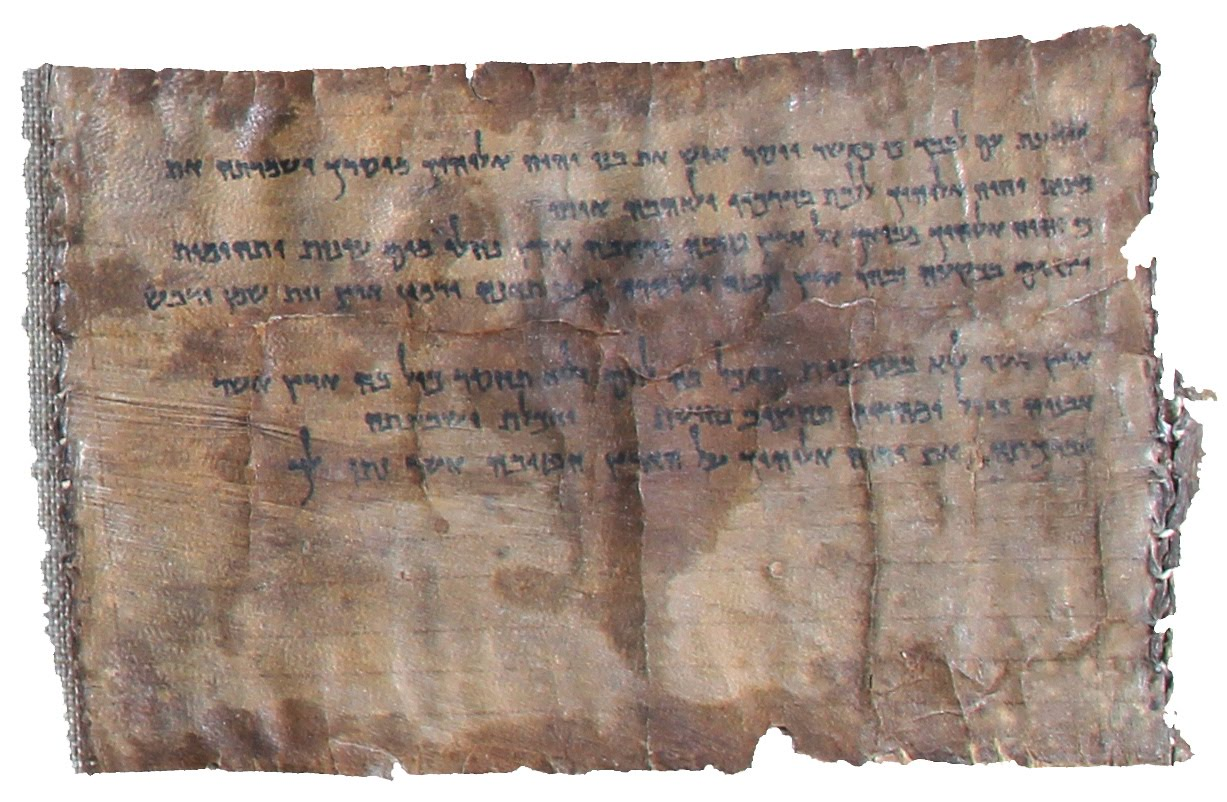4Q41 1 on:
[Wikipedia]
[Google]
[Amazon]
4Q41 or 4QDeuteronomyn (often abbreviated 4QDeutn or 4QDtn), also known as the All Souls Deuteronomy, is a
Hebrew Bible
The Hebrew Bible or Tanakh (;"Tanach"
'' Book of Deuteronomy. Discovered in 1952 in a cave at
/ref>
/ref> Its script is unusually tiny and the letters Waw (letter), waw and yod are almost indistinguishable, making some readings uncertain. The orthography employed by the scribe is much fuller than the Masoretic text and the Samaritan Pentateuch.
 The two sheets contain Deuteronomy 8:5-10 and Deuteronomy 5:1-6:1. Although the scroll was originally longer, the unusual ordering of the texts suggests it probably was not a regular biblical scroll, but contained only excerpts from Deuteronomy, possibly for liturgical or devotional purposes. Another explanation, suggested by Dead Sea Scrolls scholar
The two sheets contain Deuteronomy 8:5-10 and Deuteronomy 5:1-6:1. Although the scroll was originally longer, the unusual ordering of the texts suggests it probably was not a regular biblical scroll, but contained only excerpts from Deuteronomy, possibly for liturgical or devotional purposes. Another explanation, suggested by Dead Sea Scrolls scholar
4Q41
at the Leon Levy ''Dead Sea Scrolls Digital Library''
* White, Sidnie Ann, ''The All Souls Deuteronomy and the Decalogue'' in ''Journal of Biblical Literature, 109/2 (1990) 193-206 {{Dead Sea Scrolls Dead Sea Scrolls Q4,041 1st-century BC biblical manuscripts
'' Book of Deuteronomy. Discovered in 1952 in a cave at
Qumran
Qumran ( he, קומראן; ar, خربة قمران ') is an archaeological site in the West Bank managed by Israel's Qumran National Park. It is located on a dry marl plateau about from the northwestern shore of the Dead Sea, near the Israeli ...
, near the Dead Sea, it preserves the oldest existing copy of the Ten Commandments
The Ten Commandments (Biblical Hebrew עשרת הדברים \ עֲשֶׂרֶת הַדְּבָרִים, ''aséret ha-dvarím'', lit. The Decalogue, The Ten Words, cf. Mishnaic Hebrew עשרת הדיברות \ עֲשֶׂרֶת הַדִּבְ ...
.
Discovery
The scroll was found in the fourth Qumran cave, which was discovered by Ta’amireh bedouin in August 1952. It was later purchased for "several thousand dollars" on the black market byFrank Moore Cross
Frank Moore Cross Jr. (1921–2012) was the Hancock Professor of Hebrew and Other Oriental Languages Emeritus at Harvard University, notable for his work in the interpretation of the Dead Sea Scrolls, his 1973 ''magnum opus'' ''Canaanite Myth and ...
and Roland de Vaux
Roland Guérin de Vaux (17 December 1903 – 10 September 1971) was a French Dominican priest who led the Catholic team that initially worked on the Dead Sea Scrolls. He was the director of the Ecole Biblique, a French Catholic Theological S ...
with money supplied by an anonymous member of the Unitarian Church of All Souls
The Unitarian Church of All Souls at 1157 Lexington Avenue at East 80th Street in the Upper East Side of Manhattan, New York City was built in 1932 and was designed by Hobart Upjohn – Richard Upjohn's grandson – in the Neo-colonial ...
(Mr. Thayer Lindsley) in New York. This then gave rise to the name 'All Souls' Deuteronomy.
Description
What is preserved of the scroll consists of two fragments that were originally sewn together. They were cut evenly at the bottom to a height of 7.1 cm and have a total length of about 45 cm. The first, containing one column of writing, was not the beginning of the scroll, as can be seen from the sewn edges on either side. The second sheet contains three complete and two damaged columns. The scroll was prepared with horizontal and vertical lines, as well as ink dots to mark the beginning of lines. The exceptionally well-preserved parchment used for 4Q41 is quite small compared to other Qumran scrolls.Cohn, Yehudah, ''Tangled Up in Text: Tefillin and the Ancient World'', Society of Biblical Literature, 2008, p. 7/ref>
Date and script
The manuscript is dated on paleographic grounds to the early Herodian dynasty, Herodian period, between 30 and 1 BC.Van Beek, Gus Willard, ''Scrolls from the Wilderness of the Dead Sea: A Guide to the Exhibition, The Dead Sea Scrolls of Jordan'' University of California Press, 1965, p. 3/ref> Its script is unusually tiny and the letters Waw (letter), waw and yod are almost indistinguishable, making some readings uncertain. The orthography employed by the scribe is much fuller than the Masoretic text and the Samaritan Pentateuch.
Contents
 The two sheets contain Deuteronomy 8:5-10 and Deuteronomy 5:1-6:1. Although the scroll was originally longer, the unusual ordering of the texts suggests it probably was not a regular biblical scroll, but contained only excerpts from Deuteronomy, possibly for liturgical or devotional purposes. Another explanation, suggested by Dead Sea Scrolls scholar
The two sheets contain Deuteronomy 8:5-10 and Deuteronomy 5:1-6:1. Although the scroll was originally longer, the unusual ordering of the texts suggests it probably was not a regular biblical scroll, but contained only excerpts from Deuteronomy, possibly for liturgical or devotional purposes. Another explanation, suggested by Dead Sea Scrolls scholar John Strugnell
John Strugnell (May 25, 1930, Barnet, Hertfordshire, England – November 30, 2007, Boston, Massachusetts) became, at 23, the youngest member of the team of scholars led by Roland de Vaux, formed in 1954 to edit the Dead Sea Scrolls in Jeru ...
, is that the scroll was repaired incorrectly.
The text of the decalogue generally follows Deuteronomy, but is in some places modified to bring it in harmony with the parallel version in Exodus. One significant variant, unique to this manuscript, is the addition of the reason for the institution of the sabbath, normally found only in the account in Exodus.White, p. 201
References
External links
4Q41
at the Leon Levy ''Dead Sea Scrolls Digital Library''
Literature
* Tov, Emmanuel, ''Hebrew Bible, Greek Bible and Qumran: Collected Essays'', Mohr Siebeck, 2008* White, Sidnie Ann, ''The All Souls Deuteronomy and the Decalogue'' in ''Journal of Biblical Literature, 109/2 (1990) 193-206 {{Dead Sea Scrolls Dead Sea Scrolls Q4,041 1st-century BC biblical manuscripts